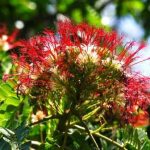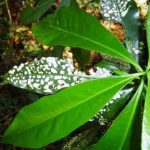TREE LIFE
May 2006
Please note that with immediate effect the post office box number for the Tree Society has changed to:
P.O. BOX A 273 AVONDALE HARARE
MASHONALAND CALENDAR
Saturday 6th May: Botanic Garden Walk. Meet Tom in the car park at 10.45 for 11 am.
We will continue with the fig family – Moraceae.
Sunday 21st May: The 56th AGM of the Tree Society will be held at the educational centre in the Botanic Gardens, Fifth Street, all facilities are available and there will be no charge at the gate. Once again we would like to thank the Head of the Herbarium and Botanic Garden, Nozipo Nobanda for this generous gesture to the Tree Society.
The meeting will start after tea which will be served at 9.30 am After the AGM we will walk around the garden, and then have our lunch back at the educational centre.
Please bring something to share for tea and your chair and lunch.
Saturday 27th May: Mark’s Walk is cancelled.
Saturday 3rd June: Tom will lead the walk in the Bot Gardens on Saturday at 11 am.
MATABELELAND CALENDAR.
Please contact Jean Wiley or Gill Short for details of the next Matabeleland function.
SUBSCRIPTIONS ARE DUE NOW FOR 2006/7
Email Z$160,000
Printed copy: collected Z$320,000
Printed copy: posted Z$800,000
If paying by cheque, please make it out to CABS and on the reverse ‘Pay to the account of the Tree Society’
Mark Hyde
VAL D’OR: 19 MARCH 2006
As I knew I was going to arrive late for the outing to Val D’Or, I asked Bart Wursten to lead in the early part of the walk. I understand that both he and Meg Coates Palgrave steered the group (a respectable 24 attendees) and thanks are due to both of them for their assistance.
This write-up therefore deals only with the later part of the morning and the walk in the afternoon. Furthermore, by the time I arrived most of the common trees had been dealt with and we were about to head back to the garden for lunch.
Firstly, what can we say about Val D’Or? Since we discovered it in c. 2000 it has been a regular venue for the Tree Society for full day outings, Saturday afternoon walks and two Christmas Socials. Part of its attraction is the unfailing welcome from Bill and Fiona.
The habitat is basically sandy miombo woodland at a high-ish altitude of around 1530 m, not unlike Cleveland Dam in both respects, and indeed it contains many similar species. It is also quite similar to the Mukuvisi Woodland and also Kutsaga, where we had been the previous month.
In addition to these habitats, a stream bearing a series of small dams runs through the property providing a range of aquatic habitats, including deep water, stream sides, marshes and a fairly dense Syzygium cordatum forest below the dam. It was in the latter that the first Central Division record of Drymaria cordata was discovered.
There are some low rocky hills (big enough to support Brachystegia glaucescens) and some areas of open grassland and scrub. At some point in its history, the property was a nursery and this leads to a wide range of planted and naturalised species occurring together with the usual weeds characteristic of areas near Harare.
All in all it is a rich and interesting area, perhaps not in an absolutely pristine state, but still very interesting, particularly for herbaceous plants.
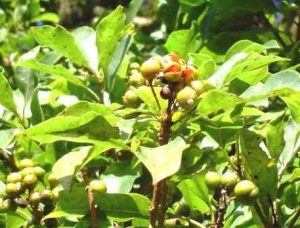
Pittosporum viridiflorum. Photo: Bart Wursten. Source: Flora of Zimbabwe
I caught up with the party near one of the lower dams. A very common tree in this area is Pittosporum viridiflorum (the Cheesewood). We see this very frequently around Harare and Val D’Or is no exception. Often it is a bushy shrub or small tree, occurring as an evergreen understorey in the deciduous Brachystegia/ Julbernardia woodland. The bark is distinctively lenticellate and the fruits are small capsules which contain orange sticky seeds.
In the dam itself was floating the Kariba weed, Salvinia molesta. Bill explained that this had escaped from a small pond further up but they were managing to keep it down, if not eliminate it completely, by regular removal.
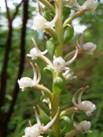
Satyrium anomalum. Photo: James Varden. Source: Flora of Zimbabwe
Heading back towards the house, we detoured into a dark Cupressus (Cypress) forest. Here, on a visit in mid January, earlier this year, Bart and I had found numerous specimens of the orchid Satyrium anomalum. Like all Satyriums this species has two spurs. The anomaly implied by the specific name is that these curve upwards whereas most of the others point downwards. It was an interesting find because once again it shows an orchid exploiting a completely exotic habitat (as Disperis spp. and Cynorkis kassneriana notably do). Here in the deep shade, the orchid was almost completely free from competition.
At this time of the year, the flowers had long gone, although the leaves were still visible. Very few species colonise this habitat, but we did see Biophytum petersianum, a tiny plant with leaves which are sensitive to the touch and a species of Commelina.
Also, more striking, was a parasitic species of broom rape, namely Orobanche minor. This is a brown plant with purplish flowers; it has no chlorophyll at all and therefore is completely parasitic. Host plants of this genus may be many metres away from the parasite and it is often not clear which is the host species.
Back at the homestead, we enjoyed a sociable lunch and in the afternoon started off again across the dam on a second walk. As we were passing an old building, we noticed a strange fleshy-leaved climber, which I couldn’t place, climbing in a Strychnos spinosa. Further examination showed that the lower parts were covered in extraordinary spines. Clearly, here was something totally new and unexpected.
A moments thought suggested Pereskia aculeata, (the Barbados gooseberry or Leaf cactus) a cactus, but a highly unusual one which possesses ordinary-looking leaves instead of the usual flattened spiny stem-like structures. There are no records of this species as an escapee in Zimbabwe, although it is quite a significant invader in S Africa, but it does appear to be cultivated here and this was probably a successful persistent relic of cultivation. We looked around near the little building but there appeared to be no more.
The treatment of relics of cultivation in floras is always difficult because many, but by no means all, plants will survive for a while if they are planted in the wild. Although not strictly part of the native flora, they are helpful to include because often the visitor (or even more experienced botanists) do not know that they are cultivated.
One of the other interesting discoveries of the morning was flowering specimens of Babiana hypogea This is a very attractive bluish-mauve herb from the Iridaceae which grows in sandy woodland. I haven’t seen it very often before – in fact only once, in the Mukuvisi Woodland – but it may be overlooked. It was fairly plentiful here and a most attractive species it is too.
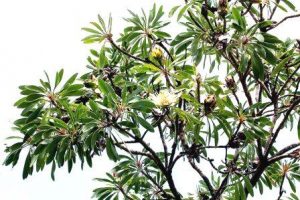
Protea gaguedi. Photo: Bart Wursten. Source: Flora of Zimbabwe
After this we walked along a fence line, on the boundary with Caledonia Farm. Here were both Protea gaguedi and Protea angolensis. Someone (I think it was Meg Coates Palgrave) pointed out how in gaguedi, the flowers close up when they die, whereas in angolensis they remain open.
The small suffrutex, Rhus kirkii was very common. We also looked at and discussed Terminalia stenostachya and its relationship with Terminalia sericea. A host of herbaceous plants of interest were found.
All in all, it was a very interesting and productive day with a great deal of interest. My thanks go to Bill and Fiona for putting up with us yet again (we’ll be back I’m sure) and to Bart and Meg and everyone else who contributed to the taxonomic discussions.
Finally, if anyone has internet access, a list of the species found on this day (and most of our recent outings) may be found by visiting:
https://www.zimbabweflora.co.zw/speciesdata/utilities/index.php
and searching for records made on the particular date.
-Mark Hyde
BOTANIC GARDEN WALK: 7TH MARCH 2006 TREES IN FRUIT
In Tom’s absence, Meg Coates Palgrave kindly stepped in to lead us. The object of the walk was to see what different types of fruiting trees could be found in the Gardens. There was a considerable array of different types; the following are some notes which I hope give a good impression of the range of variation encountered.
Our first tree was Grewia flavescens var. flavescens, the Donkey berry. This is one of the commonest grewias and is usually readily recognisable by its square stems. Fruits (in the genus) occur singly, in pairs, 3s or even 4s. Do the little clusters of 4 fruits resemble donkey droppings – hence the name?
Antidesma venosum, the Tassel berry, on the other hand bears its fruits in pendent spikes; these start off green, turn red and are finally black. This is a species with shiny leaves, often in riverine vegetation. Traditionally this species is placed in the Euphorbiaceae; however a proposed new classification puts it into a split family, the Phyllanthaceae.
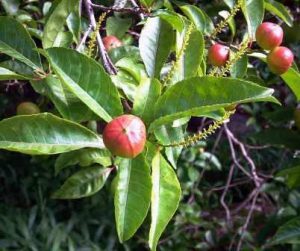
Excoecaria bussei. Photo: Bart Wursten. Source: Flora of Zimbabwe
Another Euphorbiaceae is the Pawnbroker tree, Excoecaria bussei. This has inflated fruits with 3 compartments, each containing a seed, the arrangement bearing a resemblance to the pawnbroker’s sign.
On next to the Tamarind, Tamarindus indica. This looks like the Mountain acacia, Brachystegia glaucescens; both have paripinnate leaves with numerous leaflets.
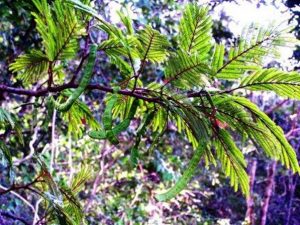
Newtonia buchananii. Photo: Bart Wursten. Source: Flora of Zimbabwe
Newtonia buchananii is an Eastern districts species from the Mimosa subfamily. It has fairly normal pods, but, most unusually, they only open down one side and remain fused on the other.
In the same family is Entada abyssinica; this has fruits which bear the seeds within a wiry frame; each segment of the fruit splits away transversely bearing a seed. Albizia versicolor has pods which split in the more usual way; these appear unusually late in the year (August / September).
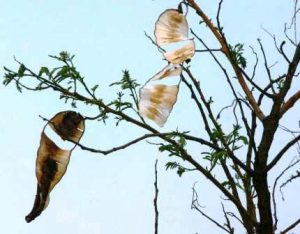
Entada abyssinica. Photo: Mark Hyde. Source: Flora of Zimbabwe
The sausage trees in the Gardens lacked fruits but both trees were absolutely covered with the “strings” which bear the large pendent fruits.
Most trees flower and fruit within a single season, but the fruits of Rothmannia manganjae take 2 years to develop, so at any one time there will be two generations of fruits on the tree.
The mopane has flat fruits, each containing one large seed. Meg explained that this was a very unusual species in southern Africa in that it is wind-pollinated; not many trees are pollinated by that method.
Sapium integerrimum’s fruits were also seen; they bear horny appendages on the outside. Peltophorum africanum has fruits typical of many legumes; a flattened pod, often with lateral wings. Mystroxylon aethiopicum was seen in flower, but this has red berries when in fruit.
This was just a miscellaneous selection of what we saw. I would like to thank Meg for a most interesting walk.
-Mark Hyde
Lynn Mullin’s talk to the Tree Society given in about 1977. Continued.
INDIGENOUS TREES
Many people have said that the Msasa grows much more quickly than I have indicated; but I doubt if their observations have been on seedling material growing in open competition with other trees in the woodland. My guess is theirs have been on regrowth material in old, cleared or stumped lands. These trees, with already well developed root systems, do grow very much more rapidly at first.
I have no facts upon which to base the rate of growth or age of the trees in our Eastern Border high forest areas. One might expect it would be somewhat faster than that of the Savannah because of the higher rainfall; but this may not be so, for, just because of this factor the plant population is always very much denser in the high forest and the increased competition for moisture and soil nutrients probably slow everything down to very much the same level. Height growth is usually greater in high forest because of the competition for light.
When talking of our high forest one immediately thinks of the big tree in the Mt. Selinda forest. I have no accurate figures for the diameter of this tree; but should say, at a guess, that above the root buttresses it must be about 8 feet or about 100 inches. If my surmise that the rate of diameter increment is much the same in high forest as in the Savannah, then this tree is only some 500 years old. Only half the age normally attributed to it. It is certainly a big tree, estimated to contain some 6500 cubic feet of timber and to be some 200 feet in height. 100 feet to the first branch. This volume represents 6500 gum poles 17 feet in length with 2-3″ tips. However, the growth rate of this species Khaya nyasica – the so called Banket Mahogany – is, by comparison with many other indigenous species, very fast.
Here in Salisbury we have at least two huge garden specimens which probably many of you know. One in the court yard of Katanga Court, planted by Mrs Osler in the 1925/26 rainy season, was in January 1970, 39 inches in diameter and 75 feet in height. The other is on the West of Second Street extension in the corner between Sheffield and Lincoln Roads. It was planted by Mr. McLauchlan in about 1917/18 and is now over 4 feet in diameter and over 64 feet in height with a crown spread of 81 feet. These show a rate of growth of almost one inch per year in diameter. Unfortunately their lives are probably in jeopardy because of their proximity to buildings – especially the one at Katanga Court. I wish because of their size, and beauty and of their known history that they could be preserved for posterity; but I suppose this is too much to expect in these times of progress. There was an Ndunga tree, Maesopsis eminii which had been growing in the grounds of the Old Agricultural Department since about 1929 and which I thought was the only one in Salisbury which was felled to allow for the Earl Grey buildings. I have since located another in Milton Park which was planted about the same time by Mr. Justice-Jarvis. It was probably from the same lot of seed which was sent to the Forestry Department from the Congo at that time. I remember some coming to us on Stapleford Forest Reserve; but we failed to get any to germinate. The tree is a native of the Congo and probably of parts of Zambia. Let us hope it is never found necessary to remove Mother Patrick’s two Cypresses. One of these was blown over in a storm during the 1976/77 rainy season.
Another tree which has recently especially interested me concerning its age is the gigantic Baobab Adansonia digitata. Are these trees really as old as people are inclined to think? I wonder! There certainly are some very large specimens in this country – as large as I have seen anywhere. I have heard of dimensions of 100 feet and more in circumference, but how the measurements were made, I do not know. Where there are irregularities such as buttressing and fluting etc. one has to be very careful how the measurements are taken and the job almost amounts to a survey. It is the basal area that is needed to allow the true diameter to be arrived by calculation. I know the Big Tree at the Victoria Falls but do not know its statistics. Because of the buttressed base it is difficult to get a true measurement for the Big Tree at Mt. Selinda. I have here with me, for you to see a cross-section of an Olive, Olea africana which I am sure will illustrate why great care must be taken in measuring the diameter of the irregular bole of a tree.
There are three Baobabs the ages of which I do know and the diameters of which I have measured, which do give some indication of early rates of growth. The largest is in the Sinoia Town Gardens. This tree was planted from seed in 1907 by Mr. Howel. In January this year it was 70 1/2 inches in diameter, which means it is increasing its diameter by approximately one inch a year. Another is in the grounds of the District Commissioner’s Office at Mrewa and was planted in 1950 by Mr. Ling who was D.C there at the time. This tree is now 20 3/8 in diameter, again indicating an increase of almost one inch per year. Yet a third – the smallest and last – is here in Highlands, planted in January 1951 by Mr. Lemmer. It was 10 1/2 inches in diameter last year indicating an annual increase of only 1/2 inch. If these rates of growth are maintained a tree 100 feet in circumference, i.e. 32 feet in diameter, may only be some 400 years old if it is increasing at one inch a year, or 800 years old if at half an inch a year.
In considering whether this rate of growth can be maintained one has to try to correlate crown and possible root development with the size of the tree. This would have to be in proportion to the diameter in order that the stem would receive a fairly constant supply of nourishment. I am afraid I cannot answer this question myself yet. I did hear once that a member of the Commission had traced a root of a large Baobab for a distance of 400 yards; if the tree can feed to such a colossal distance, I feel it might even maintain a high rate of growth. By the same token I have read that material taken from the central core of a tree felled in the Kariba Lake bush-clearing operations which was 16 feet in diameter was carbon dated at 1015 years. This takes me back to my first figure for estimating the age of our indigenous trees – multiplying the diameter in inches by five. If this is done with this particular specimen the answer is 950 years, which is not far short of the carbon dating. At the same rate a tree 32 feet in diameter would be almost 2000 years old.
An interesting feature of some of these very large Baobabs is that they are hollow from the top and then the interior is covered with bark. When this happens the hollow catches water in the rains, this can often prove a boon to the thirsty traveler.
I have made mention of the Olive tree, a tree like the Cedar of Lebanon of great Scriptural significance. It may not be generally known; but may interest you to know that in Rhodesia are a number of trees, at least eight, which, if not exactly the same species as those mentioned in the Bible, are closely related to them.
The Olive is of special significance because of Christ’s associations with it on the Mount of Olives; but before the New Testament was written it was referred to many times in the Old. In fact it is the second tree mentioned by name in the Bible (Gen 8,VII). The dove sent out from the Ark by Noah returned with an Olive leaf. The first is Fig (Gen 3V7). The wood of the Olive was well known for its qualities of strength, beauty and durability and it was from this wood that the two Cherubim on the Ark of the Covenant in Solomon’s Temple were carved (I Kings 6.23). The doors of the Oracle (Ver. 31) and the door posts of the Temple itself (Ver.33).
This tree is widespread in this country though nowhere common. It grows on the banks of the Umfuli River in Mondoro T.T.L. where I know one 4 feet in diameter – probably in the region of 792 years old. It is also to be seen where the main Bulawayo road crosses the Serui river near Selous. On the Umtali Road it occurs on the next small stream after crossing the Macheke river and also in the dongas to the left of the road after crossing the Umtali river and to show how wide spread it is it also occurs up at Inyanga. One is right on the roadside exactly opposite the Fruit Kiosk at Claremont, and in the Matopos and at Umvuma.
Our nearest relative to the Cedar of Lebanon is the so-called Mlanje Cedar, Widdringtonia jumiperoides, which grows to a medium-sized tree high up in the kloofs and on the cliffs of our Eastern Border mountains from Inyanga down through Cashel to Melsetter District. The largest I know is on the upper reaches of the Nyamziwa River on Rhodes Inyanga Estate. It has a diameter of some 22 inches and I estimate its age at about 350 years. While on the subject of our local conifers it may not be generally known that we have three represented here, the one already mentioned, the Yellow wood, Podocarpus milanjianius, which in this country does not grow to the magnificent tree that the Yellow woods do in the Knysna forests. And lastly the East African Juniper, Juniperus procera only one specimen of which has so far been found in the Nyahokwe Ruin Site at Inyanga and must be credited to Professor Wild, Professor of Botany at our University.
Our Mukwa Pterocarpus angolensis is very closely related to the Almug or Algum tree Pterocarpus santalinus which is the Red Sandalwood of India, and which was used in the buildings of the Temple. (2 Chr. 2.V8 & 9.VII)
The Jujube tree Jisiphus spina Christi is a close relative of our Musau Ziziphus mauritiana of the Zambesi valley. Famous for the very potent alcoholic drink, Kachassu, distilled from the fruits, and also of the Donkey-berry, Ziziphus mucronata well known to most local school boys as the Wag-en-bietjie or Haak-en-stiek bos; because of its one recurved and one straight thorn in juxtaposition.
The Sycomore of the Bible is our Ficus sycomorus. One of the commonest of our wild figs. The timber is soft and porous but was used extensively in Ancient Egypt for furniture, doors, boxes and Mummy cases. It was one of these trees into which Zaechaeus climbed to see Jesus pass on His way through Jericho to Jerusalem (Luke 19.V.2-4).
The Commiphoras are well represented here and it is from this family that Frankincense and Myrrh and Bdellium are extracted.
Our Water-berry (Syzygium) trees and shrubs are closely related to the Myrtle; while our Date palm Phoenix reclinata and the true Date palm Phoenix dactylifera are very similar.
Finally, the Shittim or Shittah tree, the wood of which was used by Moses in the making of the Ark of the Testimony of its Staves (Exodus 25.V.10-13). is Acacia seyal. Although this Acacia does not occur here the Acacias, generally, are well represented. Acacia nilotica which is a near relative has hard heavy but very beautiful wood.
To get back again to my original theme rate of growth and age, I am sure I am safe in saying that by comparison most exotics tried in this country can outstrip our indigenous species. I know some Eucalyptus grandis planted by Mr. John Meikle on his farm Mountain Home at Penhalonga in 1904 which, when measured in 1958, at 54 years of age, were over 5 feet in diameter and 275 feet in height. In Melsetter near the Chimanimani Hotel are some Eucalypts, probably Eucalyptus viminalis/Nova anglica hybrids, the seed of which was brought up by the trekkers from South Africa and was planted about 1895/96 which are now over 8 feet in diameter. A Mukwa planted at the same time would now be a little over a foot in diameter. In considering the phenomenal growth rate of exotics as compared with our trees it must be remembered that most of the exotics, grown in plantation form, have been chosen partly for the very fact that they do grow rapidly. Slow growing exotics are usually discarded by foresters because of the economics of growing them. A fast-growing species is encouraged as much as possible to keep up its fast increment rate by judicious thinning of the plantation until such time as the trees reach their greatest economic size and value. At this stage clear felling takes place and the trees are converted into timber. I have stressed the fact that our indigenous trees are slow. Not only are they slow but the members of our savannah forest, which must form some 90% of our forest flora, have very short and often crooked boles. It is exceptional in this country to find Mukwa with a clear bole of more than 20 feet or a Rhodesian Teak with more than 15 feet before branching. The Forestry Commission is often asked what it is doing to replace our rapidly dwindling supplies of valuable indigenous species such as Mukwa, Rhodesian Teak and Pod Mahogany and I would answer, as much as is economically possible, and this amounts to fire protection and placing a lower limit on the diameter classes which may be exploited, and limiting the annual volume which may be cut from the area with the view to obtaining a sustained yield. The natural regeneration is there and given adequate, I stress adequate, protection will reach maturity. It is just not economical to mount large scale afforestation programmes for our indigenous species. While it is available in its primeval state it can possibly be worked economically; because it has cost nothing to establish; but to replace it economically by planting is virtually impossible.
To illustrate why this is so I will take an extreme example. The Forestry Commission has found that on average in our savannah woodland an acre of ground will only support timber to a basal area of about 100 square feet, be it indigenous or exotic. This is virtually the average carrying capacity of our soil. To improve this it will be necessary to improve our rainfall. To express this in a more easily visualised form, an acre will carry 100 trees with a mean basal diameter of 13 1/2 inches. When this area is exceeded trees start dying because of over crowding. Now what does this represent in volume? As I have already said, it is exceptional in our Savannah to find clear stems of more than 20 feet. This means therefore that at a maximum, after probably 100 years or more of growth, we cannot expect more than 2000 cubic feet of sawmill timber from an acre. Quite honestly this is very high and I would put it at much less and say not more than 1400 cubic feet. Which would give a mean annual increment of 14 cubic feet. Now suppose the 100 trees by 13 1/2 inches diameter were all Eucalyptus grandis, the volume instead of being 1400 cubic feet would more likely be 4000 cu. ft and this at 30 years or so instead of 100 years or more, indicating an M.A.I. of 130 cu. ft. as against 14. All but 10 times as much.
In our wetter Eastern Border areas, where Mukwa, Rhodesian Teak and Pod Mahogany will not grow anyway, this same volume of 4000 cu. ft. can be realised in as little as 5 or 6 years. Not only that; but our merchantable indigenous species do not regenerate from coppice and have to be re-established from seed, whereas the Eucalytpts and particularly grandis do, and so where we only get one crop in 100 years one can possibly get 3 or 4 in savannah and up to 20 in the high rainfall areas.
-Lyn Mullin To be continued.
DICK HICKS CHAIRMAN


